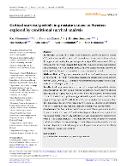Critical survival periods in prostate cancer in Sweden explored by conditional survival analysis

Author
Sundquist, Kristina
Sundquist, Jan
Foersti, Asta
Hemminki, Akseli
Hemminki, Otto
Publication date
2024Published in
Cancer MedicineVolume / Issue
13 (7)ISBN / ISSN
ISSN: 2045-7634Metadata
Show full item recordCollections
This publication has a published version with DOI 10.1002/cam4.7126
Abstract
BackroundWe wanted to characterize conditional survival in prostate cancer (PC) in Sweden around and after 2005 when the vast increase in incidence due to the opportunistic testing for prostate specific antigen (PSA) culminated. We hypothesize that analyzing survival data during that time period may help interpret survival trends. We focus on stage-specific analysis using conditional survival in order to define the periods when deaths most commonly occurred.MethodsData on PC patients were obtained from the Swedish cancer registry for analysis of 1-, 2.5- and 5-year relative survival and conditional relative survival between years 2004 and 2018. Tumor-node-metastatic stage classification at diagnosis was used to specify survival.ResultsSmall improvements were observed in stage- and age-related relative survival duriring the study period. Applying conditional relative survival showed that survival in stage T3 up to 2.5 years was better than survival between years 2.5 and 5. Survival in stage T4 was approximately equal in the first and the subsequent 2.5-year period. For M1, the first 2.5 year survival period was worse than the subsequent one. The proportion of high risk and M1 disease in old patients (80+ years) remained very high and their survival improved only modestly.ConclusionsThe data indicate that M1 metastases kill more patients in the first 2.5 years than between years 2.5 and 5 after diagnosis; T4 deaths are equal in the two periods, and in T3 mortality in the first 2.5-year period is lower than between years 2.5 and 5 after diagnosis. Conditional survival could be applied to explore critical survival periods even past 5 years after diagnoses and to monitor success in novel diagnostic and treatment practices. Improvement of survival in elderly patients may require clinical input.
Keywords
age, conditional relative survival, prognosis, stage, treatment,
Permanent link
https://hdl.handle.net/20.500.14178/2624License
Full text of this result is licensed under: Creative Commons Uveďte původ 4.0 International





